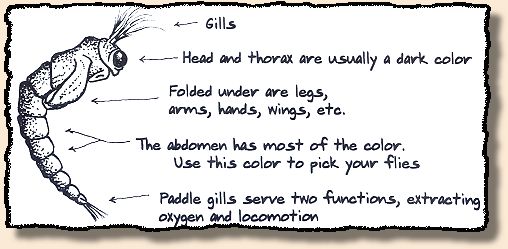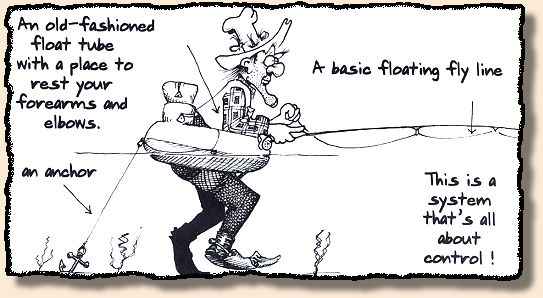Midges, of one species or another, hatch out every day of the year
unless the lake is frozen over. This means that even though the winter
hatches aren't very big they do provide food for the fish during the
lean seasons. Some scientist types even believe that trout couldn't
exist in lakes if this order of insect were to suddently disappear.
In some waters these [chironomids] account for three quarters
of a fish's diet. "Chironomid" is the name you will find these
flies under at your local fly shop. One other pattern called a
"brassie" is also a midge pupa pattern.

CHIRONOMID FACTS
- Chironomids are the most plentiful insect in most lakes.
- Multiple species exist side by side, so a pumped stomach will
show chironomids of different colors. Choose your fly for the most common
color found in the stomach.
- Midge pupae are larger the farther north you fish. Warmer southern
water has several generations during a season so the little puppies don't take the
time to grow like their northern relatives, who only hatch once per season.
- My most useful sizes are on 14, 16, and 18 hooks. But I carry these
flies from size 22 through size 8.
- Olive and black are the two most common colors with tan, brown,
and red running a close second.
- The take is almost always gentle, kinda like the fish just slurps them
in. The fish is usually hooked right on the upper lip. I don't know why, but it's
true more often than not.
There are two opinions on fishing chironomids: some love them . . . some don't.
Many fishermen find them boring. I don't think they are boring but they are
demanding. As I belong to the school that loves these little guys, I carry, at
all times, two boxes full of them in all the above sizes and colors.
Chironomids move through the water in a vertical position just like the
illustration above. You will have your best luck if you duplicate this position
by using a strike indicator!
Yes, you can catch fish using the normal nymphing techniques, with a dry line
and no strike indicator, but not the lunkers on a regular basis. The standard
nymphing techniques cause the fly to go through the water sidways during the
retrieve. The big ones are sensitive to a natural presentation and will usually
ignore a chironomid moving horizontally. This is what I recommend for
shallow chironomid fishin.

Why an anchor? . . . Since the chironomids move up and down, the slightest
breeze will push you along at a good clip. This will cause the fly to come
through the water sideways. We don't want that.
Why an arm rest? . . . First, from an anchored float tube you can put your
rod tip just under the surface of the water. This gets rid of the gravity belly
and keeps you in better contact with the fly.

Second, the sunken tip allows for a proper retrieval. As you
retrieve the fly one inch at a time, any action is absorbed in the
slack of the gravity belly. This process is less tiring if you can
rest your forearms on something.
To further keep in direct contact with your fly, try to always anchor
upwind of where you want to fish. This way your fly line won't be
blowing around and carrying your fly sideways. Do everything you can
to remove every inch of slack line between you and your fly. A savy
trout will take these flies very gently and may spit it out in a heartbeat.
Slack is your worst enemy and direct contact is your best friend.
HINT:
If you are using the little corkie strike indicator, you want to put your
toothpick through the hole from the fly side and break off the point
right at the hole. This means if you throw a tailing loop it won't have
as much to snare it and foul your tippet.
If you use a hopper body indicator you don't have to worry about it,
because nothing sticks out.
Adjust the tippet to the depth of the water. Since you will probably
be fishing just outside of the weed beds, 12 to 24 inches is usually
enough. Adjust your depth to be 10 to 14 inches off the bottom.
Try to place your fly so they will run right into it.
HINT #2
On a windy day the little ripples will cause your fly to move up
and down. At times like this you don't even need to use a retreive.
Let the wind do your work for you!
 Fishing these little puppies gets lot harder when you get into
deeper water. Deep water is any water deeper than the length of
your rod. You can carefully stick your rod down and feel the
bottom to determine the depth of the lake. Use this information
to adjust your strike indicator. It works great even if your partners
think you've lost your mind. When you can't feel the bottom then
you must do two things.
Fishing these little puppies gets lot harder when you get into
deeper water. Deep water is any water deeper than the length of
your rod. You can carefully stick your rod down and feel the
bottom to determine the depth of the lake. Use this information
to adjust your strike indicator. It works great even if your partners
think you've lost your mind. When you can't feel the bottom then
you must do two things.
The first is to go to a longer tippet. But any tippet longer than your
rod means you can't use a strike indicator that won't go through
the guides on your rod.
So the second thing you have to do is go to a soft strike indicator.
You make this out of Glo Bug yarn and nail knot it to your tippet.
The beauty of this sytem is that this will reel right up through your
guides. On occassion, when I am real desperate, I use tippets to
20 feet in lenth. These I couldn't cast but feed them out behind
my float tube while I kicked along. Once the tippet was out I
would drop my anchor and start fishing. Luckily these desperate
days are few and far between. If you find yourself needing to use
this technique, then go slow and deliberate.
Murphy's law of chronomid fishing states that your strike indicator
won't go under until you look away. As long as you're watching,
it will just set on the surface . . . ignored.
Yet Another HINT
When you look away and then look back and can't find your strike
indicator, set the hook. This is a common occurrence and you will
miss a lot of fish if you are looking around too much. It's the fly
fisherman's equivalent of shoot first and ask questions later.
These little critters come straight up to the surface wiggling their tails
and, every once in a while, they stop to rest. Since they are heavier
than water, when they rest they begin to sink. After a brief rest they
will start wiggling to the surface again. Your retrieve has to reflect
this.
With the rod tip under water start one-inch strips about a second apart.
It should go like this: PULL . . .PULL . . .PULL . . .PULL . . .PAUSE . . .
PULL. . .PULL . . . PAUSE. Vary the number of pulls.
After the pupa reaches the surface, its back splits open, the adult crawls out,
inflates its wings, and flies off. As most of these are not biting insects the
'emerger' phase often happens without the fisherman even knowing it has
happened. Emerging is a very fast process and can be over in four or five
seconds when the weather is warm, a little longer when it's cold.
There are several patterns that duplicate the emerger. Some have
foam and some use CDC to float the fly in the surface film. Fish
these patterns when you see fish working the surface. Often, right
at dark is the largest hatch with the fish making real splashy rises.
This is because with only four or five seconds before the adult is
gone, the fish has to act fast or go hungry. This hatch is often
confused with a Trico hatch but if you look close or shine a light
on the water you will see empty cases floating on the surface.
~ Mike Croft
Next time more Midges!
For more on chironomids, see
Fall Midge Emerger, Tube Midge Larva
and the
CDC Suspended Midge Pupa (scroll down it's toward the bottom.)
Credits: Illustrations and excerpted text by Mike Croft,
from the Fish Bums Guide to Catching Larger Trout,
published by Frank Amato Publications.
|




 Fishing these little puppies gets lot harder when you get into
deeper water. Deep water is any water deeper than the length of
your rod. You can carefully stick your rod down and feel the
bottom to determine the depth of the lake. Use this information
to adjust your strike indicator. It works great even if your partners
think you've lost your mind. When you can't feel the bottom then
you must do two things.
Fishing these little puppies gets lot harder when you get into
deeper water. Deep water is any water deeper than the length of
your rod. You can carefully stick your rod down and feel the
bottom to determine the depth of the lake. Use this information
to adjust your strike indicator. It works great even if your partners
think you've lost your mind. When you can't feel the bottom then
you must do two things.